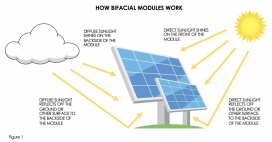Bifacial Spectrum-Splitting PV Module Designs Achieve Increased Energy Gains from Solar Power
Researchers at Quantum Energy and Sustainable Solar Technologies (QESST), a National Science Foundation (NSF)-sponsored Engineering Research Center (ERC) headquartered at Arizona State University (ASU), have designed a bifacial spectrum-splitting (BFSS) photovoltaics (PV) module that increases the energy gains possible from solar power. The invention leverages volume holographic lenses to efficiently divide the solar spectrum between cells. QESST is jointly supported by NSF and the U.S. Department of Energy (DOE).
BFSS PV modules afford higher efficiency while extending options for converting both diffuse sunlight as well as rear-side irradiance, thereby making solar power installations more feasible and effective under a greater variety of conditions. With one-axis tracking, the BFSS configuration can increase energy yield by up to 45% over conventional silicon modules, including conventional monofacial silicon, bifacial silicon, and monofacial spectrum-splitting modules. By pairing the BFSS module with additional solutions, designers can also balance energy yield with cost and size considerations to better meet constraints such as concentration ratio and aspect ratio.
QESST’s study resulted in two designs for BFSS cells – a gallium arsenide (GaAs) / bifacial silicon combination and a magnesium cadmium telluride (MgCdTe) / bifacial silicon combination. Both designs were shown to achieve higher solar efficiency. The BFSS modules use a volume holographic lens array to divide the solar spectrum into spectral bands optimized for conversion by wide-bandgap and bifacial silicon solar cells.
A major goal and advance of QESST was to develop technology that could unite the advantages of multiple technologies, providing unique opportunities for US manufacturing and advancing innovation in the United States. A high-efficiency, bifacial, flexible module enables an enormous increase in the type and number of applications for solar, enabling it to be integrated into systems such as the built environment, transport, and agriculture. A key outcome of QESST was to develop high-efficiency, bifacial, and flexible modules, and QESST’s next iterations involve further technological advances in developing integrated systems. These integrated systems are revolutionary and unprecedented in the benefits and issues they address. Some of these benefits are:
- Reducing water use in agriculture by more than 50% in sunny climates, while simultaneously increasing agriculture yield, increasing the resiliency of farming, and increasing rural development. These systems are particularly important for the regions that produce more than 75% of the food that people eat, such as the California Central Valley and Arizona.
- Advancing the U.S.’s lead in electric vehicles and addressing the issues of how to charge these vehicles. For example, a high-efficiency module and lightweight module can be integrated into parking structures, so that high-efficiency PV modules provide enough energy in the area of a parking lot to power the electric vehicle. Similarly, by integrating them into electric cars and trucks, emissions can be reduced and EV car milage can be increased, reducing the reliance on batteries and critical battery materials.
- Reducing the impact of high temperatures. The high-efficiency, specially designed PV modules can provide local cooling and could actually reduce the high nighttime temperatures that have been identified as a critical factor in the negative health impacts of heat waves.
Overall, these integrated systems go far beyond mitigating climate change by generating renewable energy and aiding in electrification; they also promote climate adaptation, reducing the impact of heat, water stress, and extreme weather. Further, the new approaches reduce the US dependence on foreign materials, and the dual-use allows multiple revenue and cost benefits, enabling U.S. manufacturing.
The approach to realizing the above advantages relies heavily on multiple innovations in the original innovation. The module combines several different innovations:
- Thin, flexible silicon solar cells. Thin solar cells allow both higher efficiency and more efficient utilization of materials for solar cells, enabling at least twice the energy to be obtained from the same amount of semiconductor material. Thin, flexible solar cells are being commercialized through a QESST start-up, Solestial, which has attracted more than $40 million in funding, employs 40 people (and growing), and is setting up a manufacturing plant in Arizona for producing the solar cells. They are initially focused on space, along with other high-value applications.
- Integrated optical components. A key innovation is the ability to integrate low-cost optical components into conventional modules via holographic films. The integration of optical components and conventional solar cell modules is important in many integrated applications. For example, it allows low-scale optical concentration, reducing the number of solar cells in a module by a factor of 2 to 4, while increasing efficiency.
- Commercial silicon and thin-film based tandems. The ultra-thin silicon modules enable efficiencies near theoretical limits; to exceed these, additional materials must be integrated into the module. QESST has demonstrated results with a number of materials.
- Integration into applications. An integrated PV module has particularly strong benefits for agriculture; and through another start-up, Sunesta Solar, Center researchers examined the benefits of agrivoltaics in arid climates along with the University of Arizona. They showed for the first time a quantitative, time-based demonstration of the benefits of agrivoltaics on several crops, showing that the agricultural output was maintained even as water was reduced by 50%.
The original research was presented at SPIE Optics and Photonics 2019 and published as B. Chrysler et al., “Spectrum-splitting Photovoltaic System using Bifacial Cells for High Energy Yield,” SPIE, 11121 (2019). Design details have also been filed as UA Invention Disclosure UA19-129.




